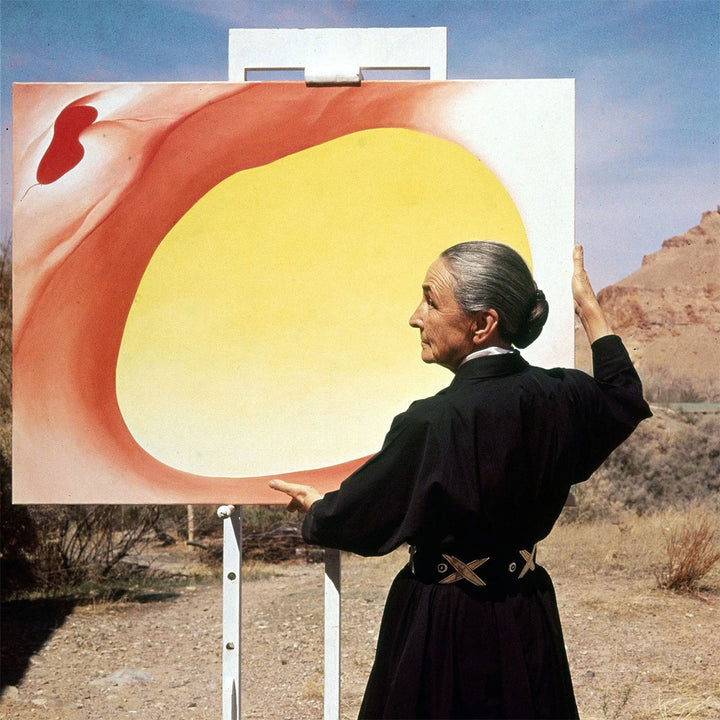
Art has often been a battleground where tradition clashes with innovation, where the past meets the future, and where the conventional butts heads with the extraordinary.
One artist who found herself in the midst of this artistic maelstrom was the iconic Georgia O'Keeffe. Known for her passionate obsession with painting flowers, O'Keeffe's work not only challenged the norms of her time but also left a lasting impression on the world of art, all while sparking a fair share of controversy.
The Blossoming of a Unique Talent
Georgia O'Keeffe was born in 1887 in Sun Prairie, Wisconsin, and from an early age, she displayed an affinity for art. Her journey to becoming one of the most celebrated American artists of the 20th century was marked by her relentless pursuit of her unique vision, unencumbered by traditional artistic boundaries.
However, it was her fascination with the natural world, particularly flowers, that would come to define her career.
O'Keeffe's fixation with flowers began during her time in New York City in the early 1920s. In a bustling metropolis filled with towering skyscrapers and bustling streets, she found solace in the tiny, delicate beauty of flowers. Her work, at this point, started to reflect this newfound passion.

The Controversy of the Up-Close and Personal
O'Keeffe's approach to painting flowers was nothing short of revolutionary. She chose to zoom in on her subjects, bringing them up close and personal. Her large-scale, detailed renderings of flowers, like her iconic "Red Poppy" and "Black Iris," were unlike anything the art world had seen before. These paintings explored the intricate details, colour and textures of the flowers, leaving viewers both enchanted and challenged.
Critics were divided. Some hailed O'Keeffe as a visionary who had unlocked a new perspective on nature. Others, however, saw her work as a direct challenge to traditional art, believing that her flower paintings bordered on the obscene due to their abstract, suggestive qualities. The debate raged on, but one thing was clear: O'Keeffe had struck a nerve.
Male critics' contention that Georgia O'Keeffe's flower paintings were erotic stemmed from her innovative approach of zooming in on the intricate details of blossoms, often highlighting the sensuous curves and suggestive forms found within nature.
Her meticulous renditions, such as the intimate portrayal of petals and stamens, invited viewers to explore the flowers' innermost secrets in a way that was both bold and unconventional for the era. This radical perspective led some to interpret her work as provocative. However, O'Keeffe vehemently refuted this claim, asserting that her intention was to convey the profound beauty and vitality of the flowers rather than engage in overtly sexual or erotic depictions. She urged viewers to see beyond the surface, encouraging them to perceive the deeper connection she felt with the natural world through her art.

Beyond Flowers: A Life in Art
While her flower paintings may have courted controversy, Georgia O'Keeffe's career extended far beyond petals and blooms. She also made a name for herself with her evocative paintings of the American Southwest, often portraying the arid landscapes, animal skulls, and adobe churches in a style that was simultaneously modern and timeless.
In addition to her stunning canvases, O'Keeffe's relationship with the famous photographer Alfred Stieglitz added another layer of intrigue to her story. Stieglitz, her mentor and husband, played a significant role in promoting her work, even as he exhibited her flower paintings, further fueling the debate surrounding her art.
Legacy of an Iconoclast
Georgia O'Keeffe's journey as an artist was one of bold experimentation and unapologetic self-expression. She not only defied traditional norms but also redefined how we perceive the world around us. Her flower paintings continue to captivate audiences worldwide, reminding us that beauty can be found in the tiniest of details and the most unexpected places.
Despite the controversies that swirled around her art, Georgia O'Keeffe remained steadfast in her pursuit of her unique vision. She once said, "I found I could say things with color and shapes that I couldn't say any other way—things I had no words for." Her work speaks for itself, transcending words and challenging our perceptions of beauty, nature, and art.
So, the next time you encounter a flower in full bloom, take a moment to appreciate its intricate beauty, and perhaps you'll catch a glimpse of the world through Georgia O'Keeffe's eyes—an artist who turned controversy into a canvas for creativity, forever blooming in the annals of art history.
Keen to read more interesting art tales?
Join our mailing list and be the first to read about mysteries, scandals and unbelievable stories from the art world.

